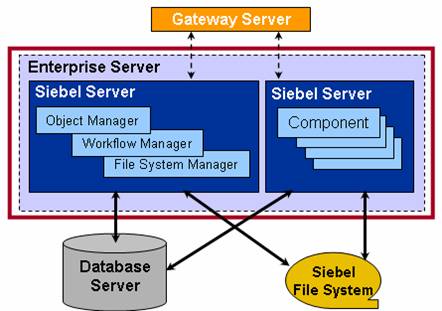Siebel Enterprise Server – An Overview
The Siebel Enterprise Server is a logical grouping of Siebel Servers that supports a group of users accessing a common Siebel Database Server,Siebel Enterprise Server can be configured, managed, and monitored as a single logical group, allowing the Siebel administrator to start, stop, monitor, or set parameters for Siebel Servers within a Siebel Enterprise Server.
You can set some Siebel Server parameters at the Siebel Enterprise Server level, and these parameters apply to every Siebel Server and component operating within that Siebel Enterprise Server
Each Siebel Server belonging to a Siebel Enterprise Server should connect to the same schema in the same database server.
The Siebel Enterprise Server, collectively with the Siebel Gateway Name Server, provides both batch mode and interactive services to and on behalf of Siebel clients.
Siebel Server Components
The various programs that operate on the Siebel Server are implemented as components. A component represents only a specific type of program.
A component is executed or operated as a task, or instantiation of a component, on a specific Siebel Server.

1. Server Component Modes
Components can execute tasks in one of three run modes.background, batch, or interactive.
a. Background mode components : Background mode components execute tasks to perform background operations for the Siebel Server. After a background mode component task starts, it runs until you explicitly stop the task, or until the Siebel Server itself is shut down.
You can manually start a background mode component by using the Siebel Server Manager. Components with a Default Tasks parameter set to a value greater than zero may start automatically when the Siebel Server is started.
Examples of background mode components include Transaction Router, Replication Agent, and Workflow Monitor Agent.
b. Batch mode components : You must manually start these components by using the component job process in the Server Manager GUI or by the Server Manager command-line interface. Batch mode components end after the task has been performed.
Examples of batch mode components include Database Extract and Enterprise Integration Manager.
c. Interactive mode components : Interactive mode components start tasks automatically in response to client requests. Interactive mode component tasks execute for as long as the client maintains the session, and end when the client disconnects.
Examples of interactive mode components include Synchronization Manager and Application Object Managers.
2. Server Component Types
Siebel Server supports multiple component types; each type performs a specific function or job. A component type is configured with a set of parameters that determine its behavior to create an entity called a defined component (or simply component).
Components are defined at the Siebel Enterprise Server level in component groups. Component groups are then assigned to one or more Siebel Servers within the Siebel Enterprise Server on which they can execute tasks.
When the Siebel Enterprise Server is installed, predefined components are automatically configured for each component type. These predefined components are then automatically assigned to each Siebel Server within the Siebel Enterprise Server.
The defined components feature allows you to create multiple defined components for a given component type, simplifying the process of starting various types of tasks using different parameters, and managing components across multiple Siebel Servers.
3. Server Component Groups
Component groups are functional areas that involve logical groupings of Siebel Server components and multiple operating system processes. A component group consists of one or more components, which may be running in one or more operating system processes. Component groups act as:
- The unit of deployment on, or assignment to, a Siebel Server. In general, you include in a Siebel Server the group of components that are deployed on one or more servers.
- A unit for monitoring functionality of the interrelated components within the group.
- A unit of control, whereby you can make available or unavailable the interrelated components in a single step, such as Siebel Remote or Workflow Management.



1 comments:
enterprise product management
"Establish customer choice at the heart of your enterprise and enable right selling through the
creation of an enterprise master catalog for all products and services."
Post a Comment